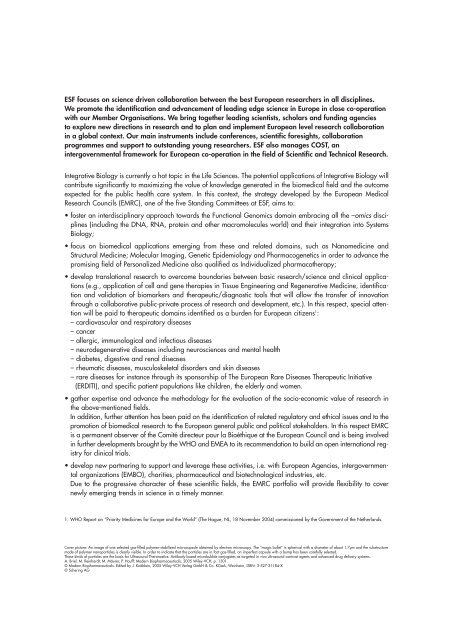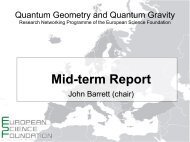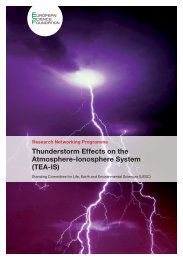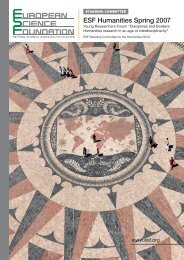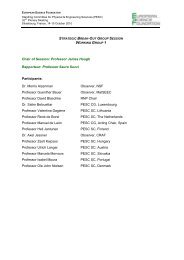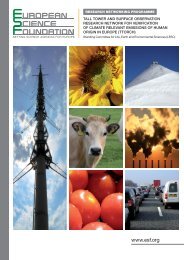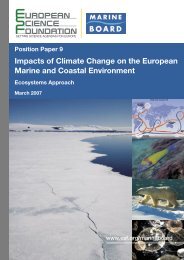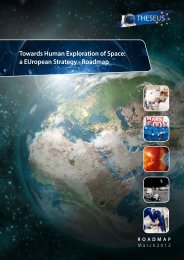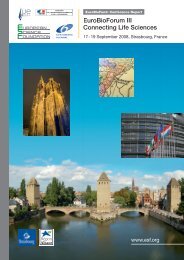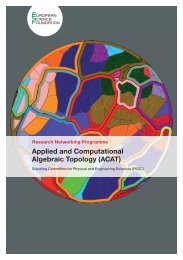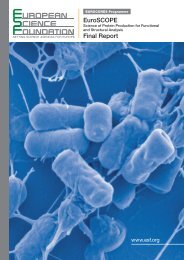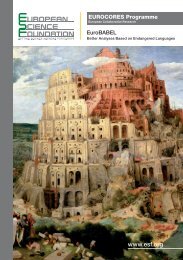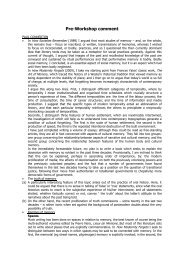Nanomedicine - European Science Foundation
Nanomedicine - European Science Foundation
Nanomedicine - European Science Foundation
Create successful ePaper yourself
Turn your PDF publications into a flip-book with our unique Google optimized e-Paper software.
ESF focuses on science driven collaboration between the best <strong>European</strong> researchers in all disciplines.<br />
We promote the identification and advancement of leading edge science in Europe in close co-operation<br />
with our Member Organisations. We bring together leading scientists, scholars and funding agencies<br />
to explore new directions in research and to plan and implement <strong>European</strong> level research collaboration<br />
in a global context. Our main instruments include conferences, scientific foresights, collaboration<br />
programmes and support to outstanding young researchers. ESF also manages COST, an<br />
intergovernmental framework for <strong>European</strong> co-operation in the field of Scientific and Technical Research.<br />
Integrative Biology is currently a hot topic in the Life <strong>Science</strong>s. The potential applications of Integrative Biology will<br />
contribute significantly to maximizing the value of knowledge generated in the biomedical field and the outcome<br />
expected for the public health care system. In this context, the strategy developed by the <strong>European</strong> Medical<br />
Research Councils (EMRC), one of the five Standing Committees at ESF, aims to:<br />
• foster an interdisciplinary approach towards the Functional Genomics domain embracing all the –omics disciplines<br />
(including the DNA, RNA, protein and other macromolecules world) and their integration into Systems<br />
Biology;<br />
• focus on biomedical applications emerging from these and related domains, such as <strong>Nanomedicine</strong> and<br />
Structural Medicine; Molecular Imaging, Genetic Epidemiology and Pharmacogenetics in order to advance the<br />
promising field of Personalized Medicine also qualified as Individualized pharmacotherapy;<br />
• develop translational research to overcome boundaries between basic research/science and clinical applications<br />
(e.g., application of cell and gene therapies in Tissue Engineering and Regenerative Medicine, identification<br />
and validation of biomarkers and therapeutic/diagnostic tools that will allow the transfer of innovation<br />
through a collaborative public-private process of research and development, etc.). In this respect, special attention<br />
will be paid to therapeutic domains identified as a burden for <strong>European</strong> citizens 1 :<br />
– cardiovascular and respiratory diseases<br />
– cancer<br />
– allergic, immunological and infectious diseases<br />
– neurodegenerative diseases including neurosciences and mental health<br />
– diabetes, digestive and renal diseases<br />
– rheumatic diseases, musculoskeletal disorders and skin diseases<br />
– rare diseases for instance through its sponsorship of The <strong>European</strong> Rare Diseases Therapeutic Initiative<br />
(ERDITI), and specific patient populations like children, the elderly and women.<br />
• gather expertise and advance the methodology for the evaluation of the socio-economic value of research in<br />
the above-mentioned fields.<br />
In addition, further attention has been paid on the identification of related regulatory and ethical issues and to the<br />
promotion of biomedical research to the <strong>European</strong> general public and political stakeholders. In this respect EMRC<br />
is a permanent observer of the Comité directeur pour la Bioéthique at the <strong>European</strong> Council and is being involved<br />
in further developments brought by the WHO and EMEA to its recommendation to build an open international registry<br />
for clinical trials.<br />
• develop new partnering to support and leverage these activities, i.e. with <strong>European</strong> Agencies, intergovernmental<br />
organizations (EMBO), charities, pharmaceutical and biotechnological industries, etc.<br />
Due to the progressive character of these scientific fields, the EMRC portfolio will provide flexibility to cover<br />
newly emerging trends in science in a timely manner.<br />
1. WHO Report on “Priority Medicines for Europe and the World” (The Hague, NL, 18 November 2004) commissioned by the Government of the Netherlands.<br />
Cover picture: An image of one selected gas-filled polymer-stabilized microcapsule obtained by electron microscopy. The “magic bullet” is spherical with a diameter of about 1.7µm and the substructure<br />
made of polymer nanoparticles is clearly visible. In order to indicate that the particles are in fact gas-filled, an imperfect capsule with a bump has been carefully selected.<br />
These kinds of particles are the basis for Ultrasound Theranostics: Antibody based microbubble conjugates as targeted in vivo ultrasound contrast agents and advanced drug delivery systems.<br />
A. Briel, M. Reinhardt, M. Mäurer, P. Hauff; Modern Biopharmaceuticals, 2005 Wiley-VCH, p. 1301<br />
© Modern Biopharmaceuticals. Edited by J. Knäblein, 2005 Wiley-VCH Verlag GmbH & Co. KGaA, Weinheim, ISBN: 3-527-31184-X<br />
© Schering AG


